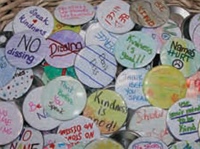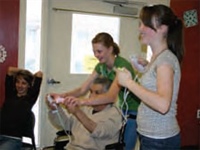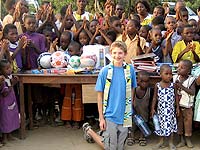Have you noticed the groundswell of volunteerism during the past few years? In 2006 alone, 60 million Americans dedicated 8.1 billion hours of service to community organizations. More recently, President Obama has emphasized his support of service and service learning.
Upon signing the Edward M. Kennedy Serve America Act in April, Obama said, “We need your service, right now, at this moment in history. I’m not going to tell you what your role should be; that’s for you to discover. But I am asking you to stand up and play your part.initiatives.
I am asking you to help change history’s course.”
Our schools and our youth have much to contribute and much to gain by joining this call. What better way to introduce our young adolescents to community and civic participation than through service-learning experiences!
What Does Service-Learning Look Like?
In the early days, we thought service-learning meant adding a small service-related project to whatever the students were studying. Or we put academics aside for an afternoon to go out and “make a difference” in the community. Now we know more and we know better.
Service-learning is a powerful, hands-on teaching and learning strategy that integrates meaningful service and classroom content. The process creates authentic learning opportunities while teaching civic responsibility through service to others with reciprocal benefits for all involved. Teachers tell me that their students go far beyond class requirements with service-learning. Students discover intrinsic motivation when they care about the subject matter and recognize a need they can fulfill. Meeting academic standards has relevance as classrooms come alive with engaged students and teachers.

Peace Rocks. No Name-Calling Week in Albion, New York. Pins created by the students.
Albion, New York: As part of the English/language arts curriculum at Albion Middle School, students participate in Peace Rocks, a year-long service-learning project. Students write fables around the theme of peace and compile them into a book for younger children. They also write poetry and take photographs documenting peaceful locales in the community to create an exhibit that chronicles the history of the community. And the students develop and lead their peers in No Name-Calling Week activities. (No Name-Calling Week is January 25–29, 2010.)
Humble, Texas: Imagine a service-learning idea transforming a campus, inspiring youth to learn more about their family history, and motivating students and faculty to make a commitment to honor a forgotten generation. History, genealogy, writing, technology, and public speaking came together around a common purpose at Clear Creek Middle School: To honor the past by teaching the community about World War I and contributing funds to The WWI Memorial Foundation Project. Clear Creek Middle School students held a well-attended event to showcase the role of veterans from their community and recognize the contributions of the surviving veterans of World War I.

Junior high students in Ogden, Utah are teaching residents at a nursing home to play the Wii.
Ogden, Utah: “What’s the need? What’s your action plan?” With these guiding questions, students at Mount Ogden Junior High learn public speaking and communication skills and witness how their individual and collective voices encourage action. When they realized some classmates needed clothes to adhere to the dress code, they held a clothing drive. When students learned the local hospital needed hats and blankets for premature babies, the students made them. And after checking with the local nursing home staff about specific needs, they taught residents how to play the Wii, which enabled the seniors to play with their visiting grandchildren.
New Orleans, Louisiana: Isadore Newman School class of 2014 blended social studies, English, math, science, technology, and research skills to study their community and publish a book, Walking Through New Orleans. As part of the In Our Global Village of books, they have achieved international readership. Plans for the next year? The students completed a second book, this time on post-Katrina New Orleans. (Check out their In Our Global Village project at www.inourvillage.org)
New Port Richey, Florida: Recognizing the value of a school-wide implementation of service-learning, student leaders formed a youth council that made a difference throughout the school, influencing many classrooms to design and implement meaningful activities. Drama students performed plays that taught tolerance, respect, and non-violence. Students improved their own fluency and comprehension skills while teaching reading and healthy living to elementary students. They also collected and recycled batteries and made an iMovie about the importance of recycling.
Chicago, Illinois: Middle grades students from several Chicago public schools built emotionally meaningful relationships with people with Alzheimer’s disease and related forms of dementia. After studying about the kinds of memory that dementia does not erase, students learned how to form a “Memory Bridge” to span the communication gap with older adults. During visits to long-term care communities, the students interacted with a resident “buddy,” practiced active listening, and initiated and sustained conversations that demonstrated sensitivity and insight. Students learned intra- and interpersonal communication skills that support friendship, family, and emotionally healthy communities.
Establishing a Solid Foundation
These service-learning stories build on a foundation of years of research and the collective practice of teachers who knew what worked. Today, teachers have the K–12 Standards for Service-Learning (see page 15) to help them guide students through the Five Stages of Service-Learning. In addition to these essential ingredients, keep the following thoughts in mind as you initiate or develop service-learning in your school:
| The Five Stages of Service-Learning |
| These five stages of service-learning describe what students do to transform their ideas into action. Adults provide guidance and ensure students’ skills and knowledge are developed during the process.
Investigation A personal investigation is also beneficial. Students interview each other to identify each person’s interests, skills, and talents. Students reference, use, and develop these skills throughout the service-learning process. Preparation and Planning Action Reflection Demonstration/Celebration |
Adapted from the upcoming 2nd Edition of The Complete Guide to Service Learning by Cathryn Berger Kaye, copyright © 2010. Free Spirit Publishing Inc., Minneapolis, MN; 866/703-7322; www.freespirit.com
Remember, Service-Learning Is a Team Sport. Service-learning brings teachers together to collaborate, synchronizing core curricula and electives around the central theme. Planning together maximizes teachers’ sense of ownership and generates a treasure trove of ideas.
Expect Surprises. Service-learning requires teachers to slowly release the reins and let the students find and share their ideas, voices, and choices. The excitement—and the surprises—come about when students use on-the-spot critical thinking along with their analytical, creative, and practical skills to adapt to each situation.
Infuse Literacy Through Literature. For every service-learning adventure, you can find fiction, nonfiction, and picture books to promote the transfer of knowledge and instill the desire to read. Literature helps students make instant connections between academics and the world around them. (For literature recommendations, see my book, The Complete Guide to Service Learning, available from www.nmsa.org/store.)
Build Students’ Skills. Students’ service efforts may vary, so skill development becomes the centerpiece. You can help students gain the skills they need to conduct effective interviews, make phone calls, keep accurate records, and take notes.
The investigation stage of service-learning provides an exceptional opportunity to steer students away from the Internet as the only modality for research. Take advantage of their interest to have them conduct interviews and surveys, draw from experience and observation, and use all forms of media: newspapers, radio, film, books, and magazines. Students can transfer these skills to the classroom to improve their academic performance, their competence, and their self-confidence.
Build Career Awareness. Career exploration in middle school? Absolutely! Service-learning exposes students to all kinds of careers, including opportunities in the media, local government, nonprofit sector, and in local businesses.
Staff Development Matters
Setting a common language and procedure for integrating service-learning within a school community is an excellent investment of time and resources. Offer on-site inservice programs to unify the staff and build a culture of service. Select books on service-learning to read as a faculty and establish professional learning communities to plan service-learning activities.
Learning opportunities abound with national and state conferences on service-learning and at conferences such as National Middle School Association’s annual conference in Indianapolis, where service-learning will be a major strand.
Surf the Web for a wealth of information about programs, beginning with Learn and Serve America’s National Service-Learning Clearinghouse (www.servicelearning.org).
Why Now?
Why service-learning? Why now? If the refrain we hear is, “Our plates are full,” then here’s the good news: service-learning is not an add-on, it’s really not “one more thing.” Service-learning is an approach to teaching and learning that, when implemented well, brings out the best in young adolescents. Benefits include youth engagement, school improvement, and mutual benefit for our communities near and far. Discover the reasons service-learning is right for you!
Previously published in Middle Ground magazine, October 2009
Cathryn Berger Kaye, of CBK Associates, is an international service-learning consultant and author. Her books include The Complete Guide to Service Learning and the service-learning How to Take Action series for middle grades youth. E-mail: cbkaye@aol.com
Excerpts of this article are based on The Complete Guide to Service Learning: Proven, Practical Ways to Engage Students in Civic Responsibility, Academic Curriculum, & Social Action, (2nd. Edition), by Cathryn Berger Kaye, Free Spirit Publishing, 2010.
